Analysis of Internal and External Stakeholders: The Haier Group
VerifiedAdded on 2023/01/19
|17
|4064
|38
Report
AI Summary
This report provides a comprehensive stakeholder analysis of the Haier Group, a well-known retail organization in China. It begins by outlining the functional areas within the company and then identifies both internal stakeholders, such as employees, management, and shareholders, and external stakeholders, including customers, governmental bodies, and suppliers. The analysis delves into the nature and degree of interest of these stakeholders, explores the implications of conflicting interests using the agency theory, and presents a stakeholder matrix to define their impact and influence. The report culminates in a comparison of stakeholder interests within the retail and information technology services industries, offering valuable insights into stakeholder management and its significance in the business environment.
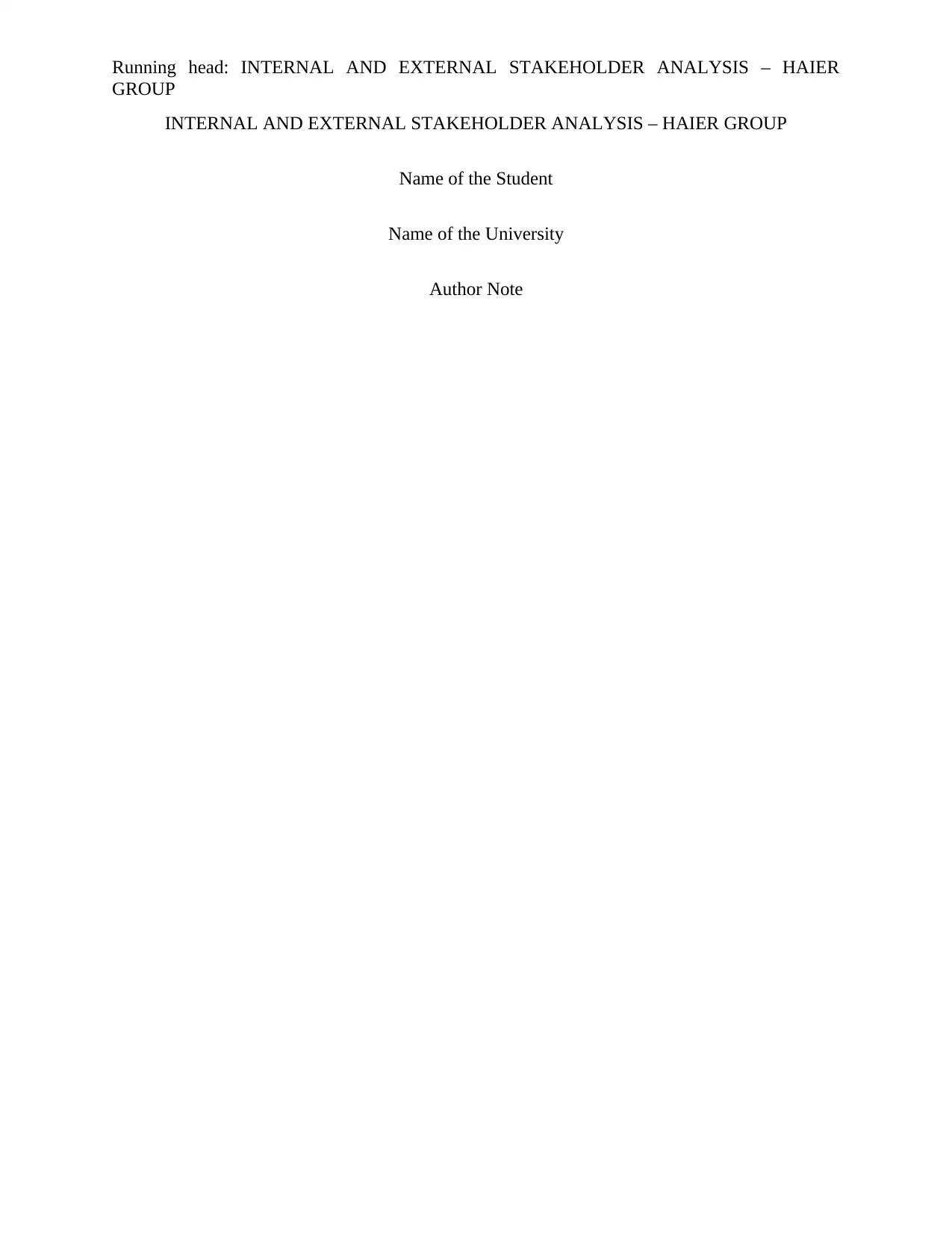
Running head: INTERNAL AND EXTERNAL STAKEHOLDER ANALYSIS – HAIER
GROUP
INTERNAL AND EXTERNAL STAKEHOLDER ANALYSIS – HAIER GROUP
Name of the Student
Name of the University
Author Note
GROUP
INTERNAL AND EXTERNAL STAKEHOLDER ANALYSIS – HAIER GROUP
Name of the Student
Name of the University
Author Note
Paraphrase This Document
Need a fresh take? Get an instant paraphrase of this document with our AI Paraphraser
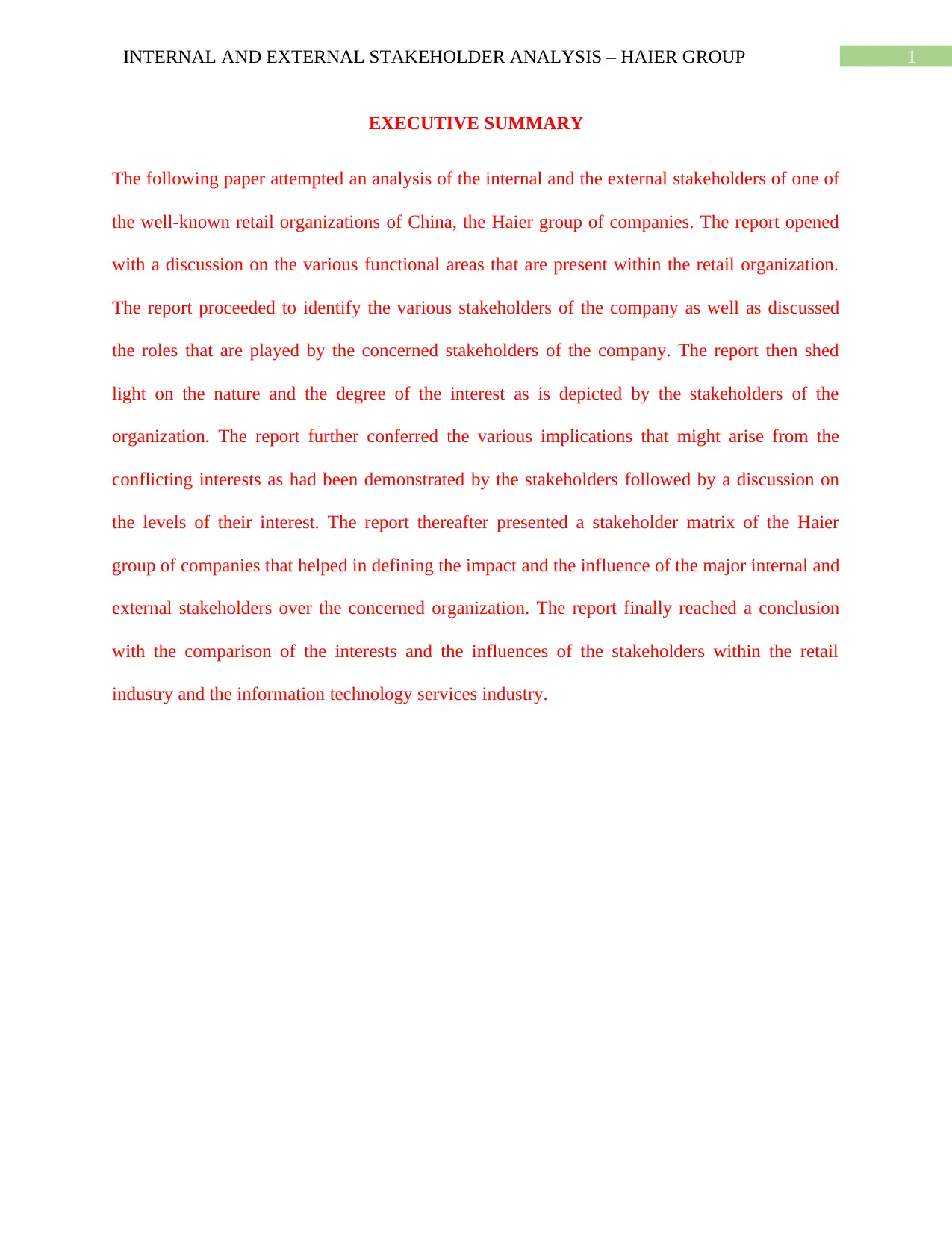
1INTERNAL AND EXTERNAL STAKEHOLDER ANALYSIS – HAIER GROUP
EXECUTIVE SUMMARY
The following paper attempted an analysis of the internal and the external stakeholders of one of
the well-known retail organizations of China, the Haier group of companies. The report opened
with a discussion on the various functional areas that are present within the retail organization.
The report proceeded to identify the various stakeholders of the company as well as discussed
the roles that are played by the concerned stakeholders of the company. The report then shed
light on the nature and the degree of the interest as is depicted by the stakeholders of the
organization. The report further conferred the various implications that might arise from the
conflicting interests as had been demonstrated by the stakeholders followed by a discussion on
the levels of their interest. The report thereafter presented a stakeholder matrix of the Haier
group of companies that helped in defining the impact and the influence of the major internal and
external stakeholders over the concerned organization. The report finally reached a conclusion
with the comparison of the interests and the influences of the stakeholders within the retail
industry and the information technology services industry.
EXECUTIVE SUMMARY
The following paper attempted an analysis of the internal and the external stakeholders of one of
the well-known retail organizations of China, the Haier group of companies. The report opened
with a discussion on the various functional areas that are present within the retail organization.
The report proceeded to identify the various stakeholders of the company as well as discussed
the roles that are played by the concerned stakeholders of the company. The report then shed
light on the nature and the degree of the interest as is depicted by the stakeholders of the
organization. The report further conferred the various implications that might arise from the
conflicting interests as had been demonstrated by the stakeholders followed by a discussion on
the levels of their interest. The report thereafter presented a stakeholder matrix of the Haier
group of companies that helped in defining the impact and the influence of the major internal and
external stakeholders over the concerned organization. The report finally reached a conclusion
with the comparison of the interests and the influences of the stakeholders within the retail
industry and the information technology services industry.
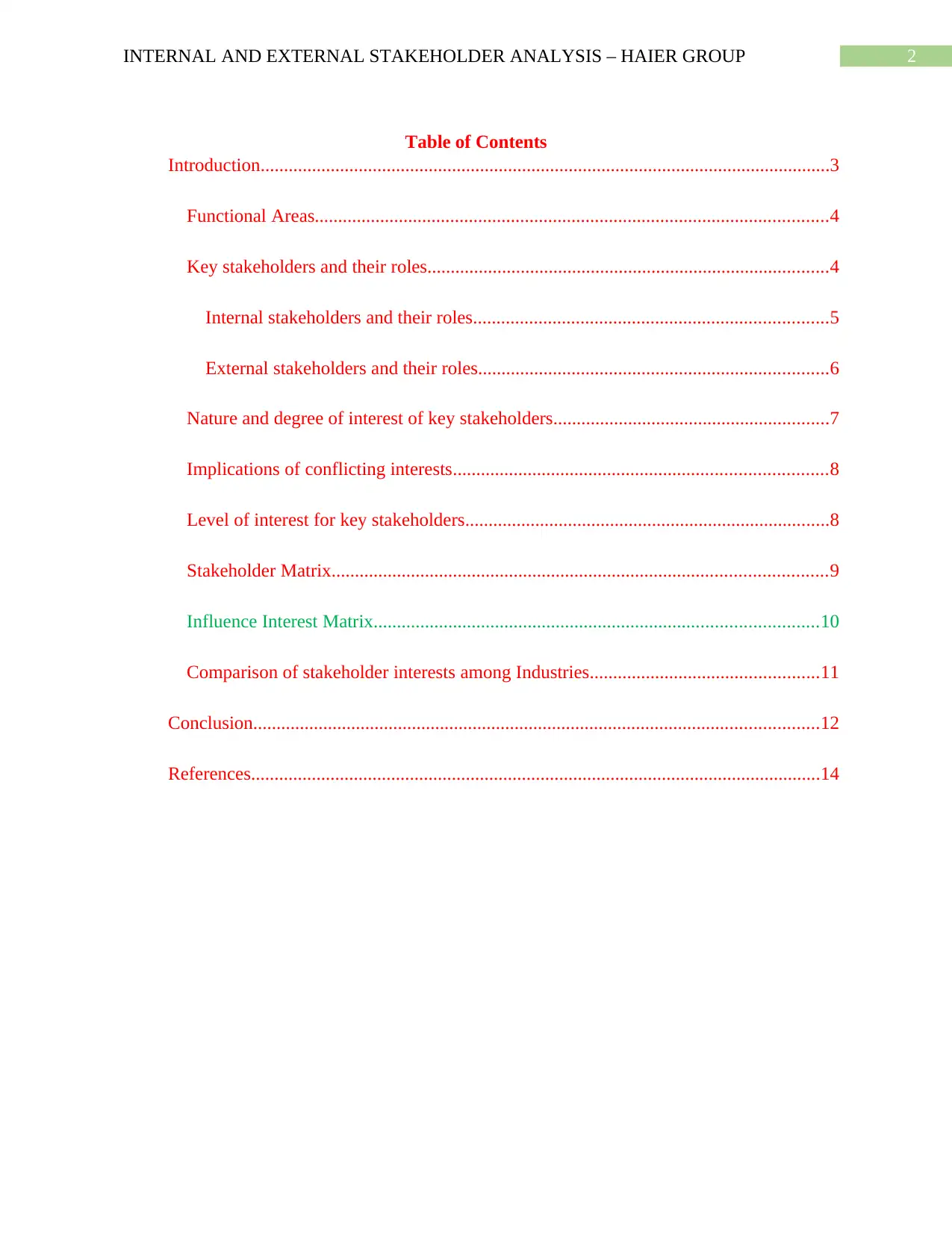
2INTERNAL AND EXTERNAL STAKEHOLDER ANALYSIS – HAIER GROUP
Table of Contents
Introduction..........................................................................................................................3
Functional Areas..............................................................................................................4
Key stakeholders and their roles......................................................................................4
Internal stakeholders and their roles............................................................................5
External stakeholders and their roles...........................................................................6
Nature and degree of interest of key stakeholders...........................................................7
Implications of conflicting interests................................................................................8
Level of interest for key stakeholders..............................................................................8
Stakeholder Matrix..........................................................................................................9
Influence Interest Matrix...............................................................................................10
Comparison of stakeholder interests among Industries.................................................11
Conclusion.........................................................................................................................12
References..........................................................................................................................14
Table of Contents
Introduction..........................................................................................................................3
Functional Areas..............................................................................................................4
Key stakeholders and their roles......................................................................................4
Internal stakeholders and their roles............................................................................5
External stakeholders and their roles...........................................................................6
Nature and degree of interest of key stakeholders...........................................................7
Implications of conflicting interests................................................................................8
Level of interest for key stakeholders..............................................................................8
Stakeholder Matrix..........................................................................................................9
Influence Interest Matrix...............................................................................................10
Comparison of stakeholder interests among Industries.................................................11
Conclusion.........................................................................................................................12
References..........................................................................................................................14
⊘ This is a preview!⊘
Do you want full access?
Subscribe today to unlock all pages.

Trusted by 1+ million students worldwide
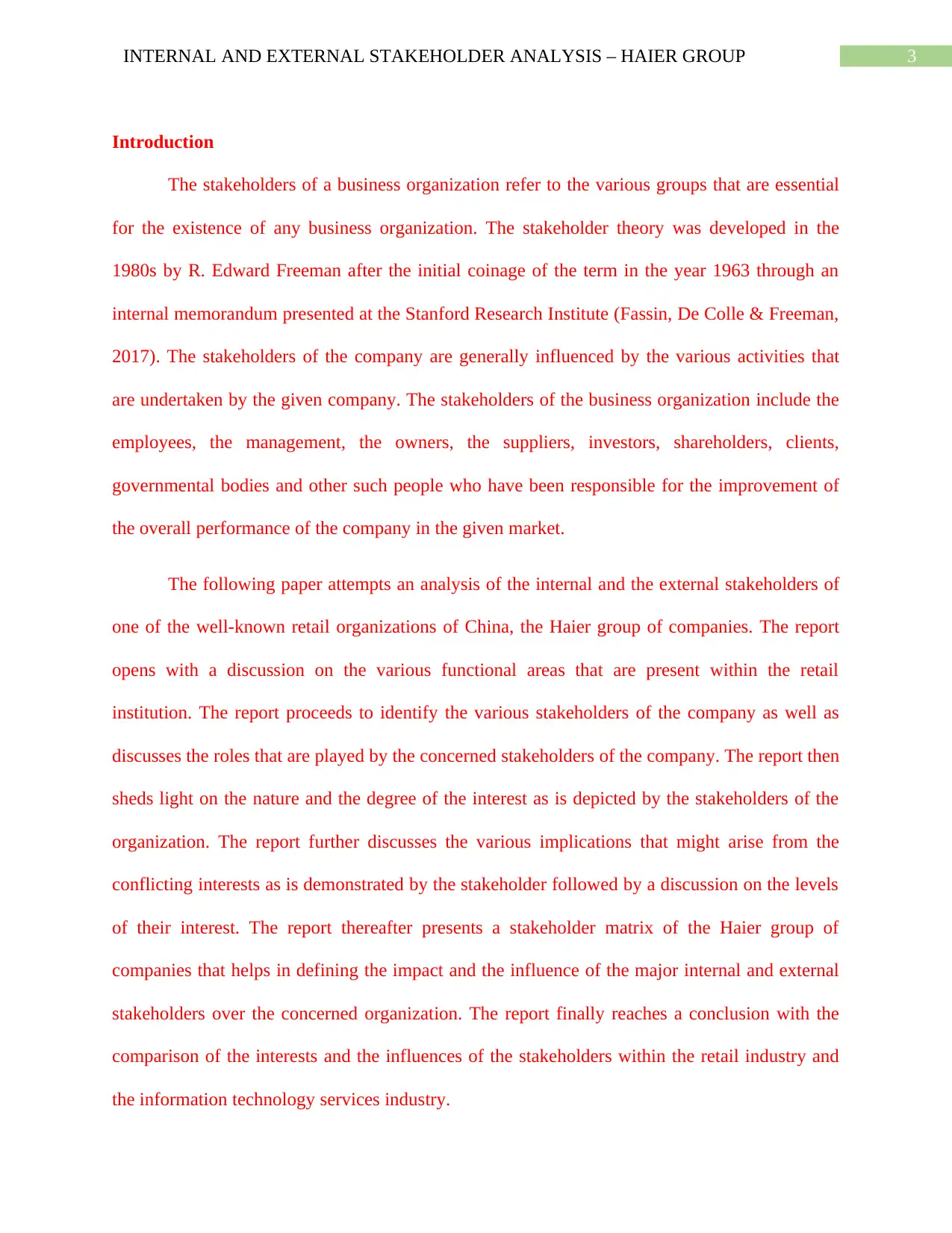
3INTERNAL AND EXTERNAL STAKEHOLDER ANALYSIS – HAIER GROUP
Introduction
The stakeholders of a business organization refer to the various groups that are essential
for the existence of any business organization. The stakeholder theory was developed in the
1980s by R. Edward Freeman after the initial coinage of the term in the year 1963 through an
internal memorandum presented at the Stanford Research Institute (Fassin, De Colle & Freeman,
2017). The stakeholders of the company are generally influenced by the various activities that
are undertaken by the given company. The stakeholders of the business organization include the
employees, the management, the owners, the suppliers, investors, shareholders, clients,
governmental bodies and other such people who have been responsible for the improvement of
the overall performance of the company in the given market.
The following paper attempts an analysis of the internal and the external stakeholders of
one of the well-known retail organizations of China, the Haier group of companies. The report
opens with a discussion on the various functional areas that are present within the retail
institution. The report proceeds to identify the various stakeholders of the company as well as
discusses the roles that are played by the concerned stakeholders of the company. The report then
sheds light on the nature and the degree of the interest as is depicted by the stakeholders of the
organization. The report further discusses the various implications that might arise from the
conflicting interests as is demonstrated by the stakeholder followed by a discussion on the levels
of their interest. The report thereafter presents a stakeholder matrix of the Haier group of
companies that helps in defining the impact and the influence of the major internal and external
stakeholders over the concerned organization. The report finally reaches a conclusion with the
comparison of the interests and the influences of the stakeholders within the retail industry and
the information technology services industry.
Introduction
The stakeholders of a business organization refer to the various groups that are essential
for the existence of any business organization. The stakeholder theory was developed in the
1980s by R. Edward Freeman after the initial coinage of the term in the year 1963 through an
internal memorandum presented at the Stanford Research Institute (Fassin, De Colle & Freeman,
2017). The stakeholders of the company are generally influenced by the various activities that
are undertaken by the given company. The stakeholders of the business organization include the
employees, the management, the owners, the suppliers, investors, shareholders, clients,
governmental bodies and other such people who have been responsible for the improvement of
the overall performance of the company in the given market.
The following paper attempts an analysis of the internal and the external stakeholders of
one of the well-known retail organizations of China, the Haier group of companies. The report
opens with a discussion on the various functional areas that are present within the retail
institution. The report proceeds to identify the various stakeholders of the company as well as
discusses the roles that are played by the concerned stakeholders of the company. The report then
sheds light on the nature and the degree of the interest as is depicted by the stakeholders of the
organization. The report further discusses the various implications that might arise from the
conflicting interests as is demonstrated by the stakeholder followed by a discussion on the levels
of their interest. The report thereafter presents a stakeholder matrix of the Haier group of
companies that helps in defining the impact and the influence of the major internal and external
stakeholders over the concerned organization. The report finally reaches a conclusion with the
comparison of the interests and the influences of the stakeholders within the retail industry and
the information technology services industry.
Paraphrase This Document
Need a fresh take? Get an instant paraphrase of this document with our AI Paraphraser
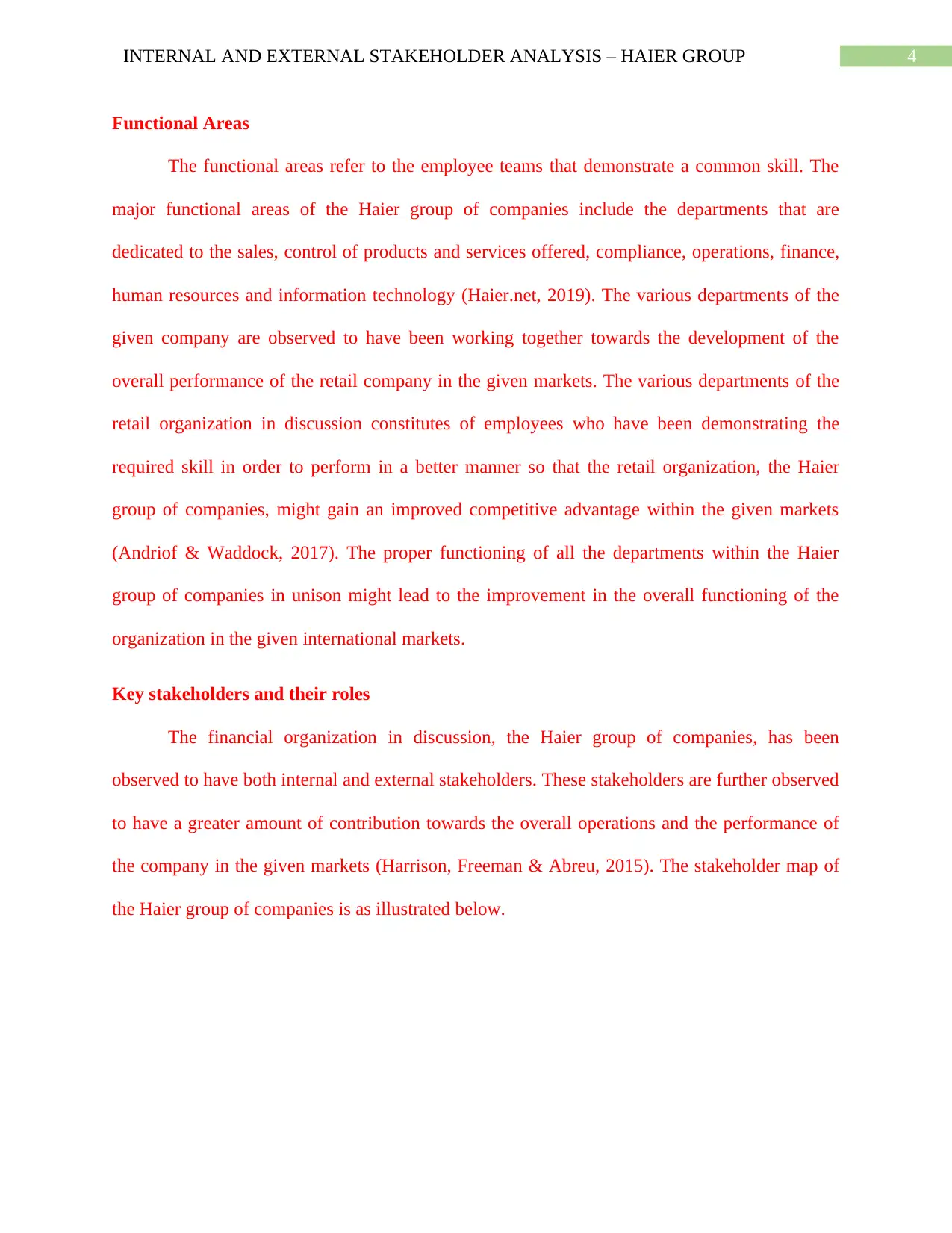
4INTERNAL AND EXTERNAL STAKEHOLDER ANALYSIS – HAIER GROUP
Functional Areas
The functional areas refer to the employee teams that demonstrate a common skill. The
major functional areas of the Haier group of companies include the departments that are
dedicated to the sales, control of products and services offered, compliance, operations, finance,
human resources and information technology (Haier.net, 2019). The various departments of the
given company are observed to have been working together towards the development of the
overall performance of the retail company in the given markets. The various departments of the
retail organization in discussion constitutes of employees who have been demonstrating the
required skill in order to perform in a better manner so that the retail organization, the Haier
group of companies, might gain an improved competitive advantage within the given markets
(Andriof & Waddock, 2017). The proper functioning of all the departments within the Haier
group of companies in unison might lead to the improvement in the overall functioning of the
organization in the given international markets.
Key stakeholders and their roles
The financial organization in discussion, the Haier group of companies, has been
observed to have both internal and external stakeholders. These stakeholders are further observed
to have a greater amount of contribution towards the overall operations and the performance of
the company in the given markets (Harrison, Freeman & Abreu, 2015). The stakeholder map of
the Haier group of companies is as illustrated below.
Functional Areas
The functional areas refer to the employee teams that demonstrate a common skill. The
major functional areas of the Haier group of companies include the departments that are
dedicated to the sales, control of products and services offered, compliance, operations, finance,
human resources and information technology (Haier.net, 2019). The various departments of the
given company are observed to have been working together towards the development of the
overall performance of the retail company in the given markets. The various departments of the
retail organization in discussion constitutes of employees who have been demonstrating the
required skill in order to perform in a better manner so that the retail organization, the Haier
group of companies, might gain an improved competitive advantage within the given markets
(Andriof & Waddock, 2017). The proper functioning of all the departments within the Haier
group of companies in unison might lead to the improvement in the overall functioning of the
organization in the given international markets.
Key stakeholders and their roles
The financial organization in discussion, the Haier group of companies, has been
observed to have both internal and external stakeholders. These stakeholders are further observed
to have a greater amount of contribution towards the overall operations and the performance of
the company in the given markets (Harrison, Freeman & Abreu, 2015). The stakeholder map of
the Haier group of companies is as illustrated below.
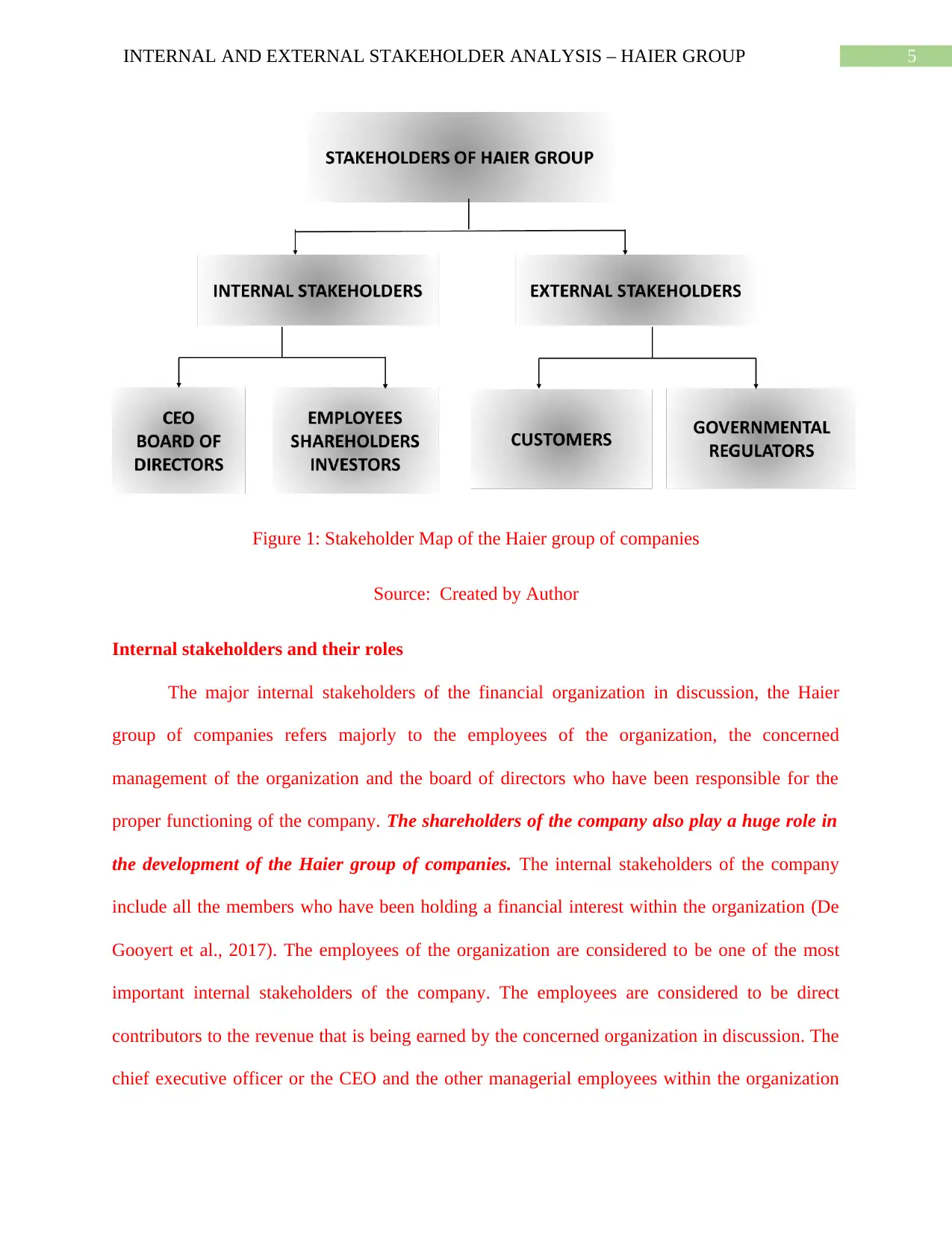
5INTERNAL AND EXTERNAL STAKEHOLDER ANALYSIS – HAIER GROUP
Figure 1: Stakeholder Map of the Haier group of companies
Source: Created by Author
Internal stakeholders and their roles
The major internal stakeholders of the financial organization in discussion, the Haier
group of companies refers majorly to the employees of the organization, the concerned
management of the organization and the board of directors who have been responsible for the
proper functioning of the company. The shareholders of the company also play a huge role in
the development of the Haier group of companies. The internal stakeholders of the company
include all the members who have been holding a financial interest within the organization (De
Gooyert et al., 2017). The employees of the organization are considered to be one of the most
important internal stakeholders of the company. The employees are considered to be direct
contributors to the revenue that is being earned by the concerned organization in discussion. The
chief executive officer or the CEO and the other managerial employees within the organization
Figure 1: Stakeholder Map of the Haier group of companies
Source: Created by Author
Internal stakeholders and their roles
The major internal stakeholders of the financial organization in discussion, the Haier
group of companies refers majorly to the employees of the organization, the concerned
management of the organization and the board of directors who have been responsible for the
proper functioning of the company. The shareholders of the company also play a huge role in
the development of the Haier group of companies. The internal stakeholders of the company
include all the members who have been holding a financial interest within the organization (De
Gooyert et al., 2017). The employees of the organization are considered to be one of the most
important internal stakeholders of the company. The employees are considered to be direct
contributors to the revenue that is being earned by the concerned organization in discussion. The
chief executive officer or the CEO and the other managerial employees within the organization
⊘ This is a preview!⊘
Do you want full access?
Subscribe today to unlock all pages.

Trusted by 1+ million students worldwide
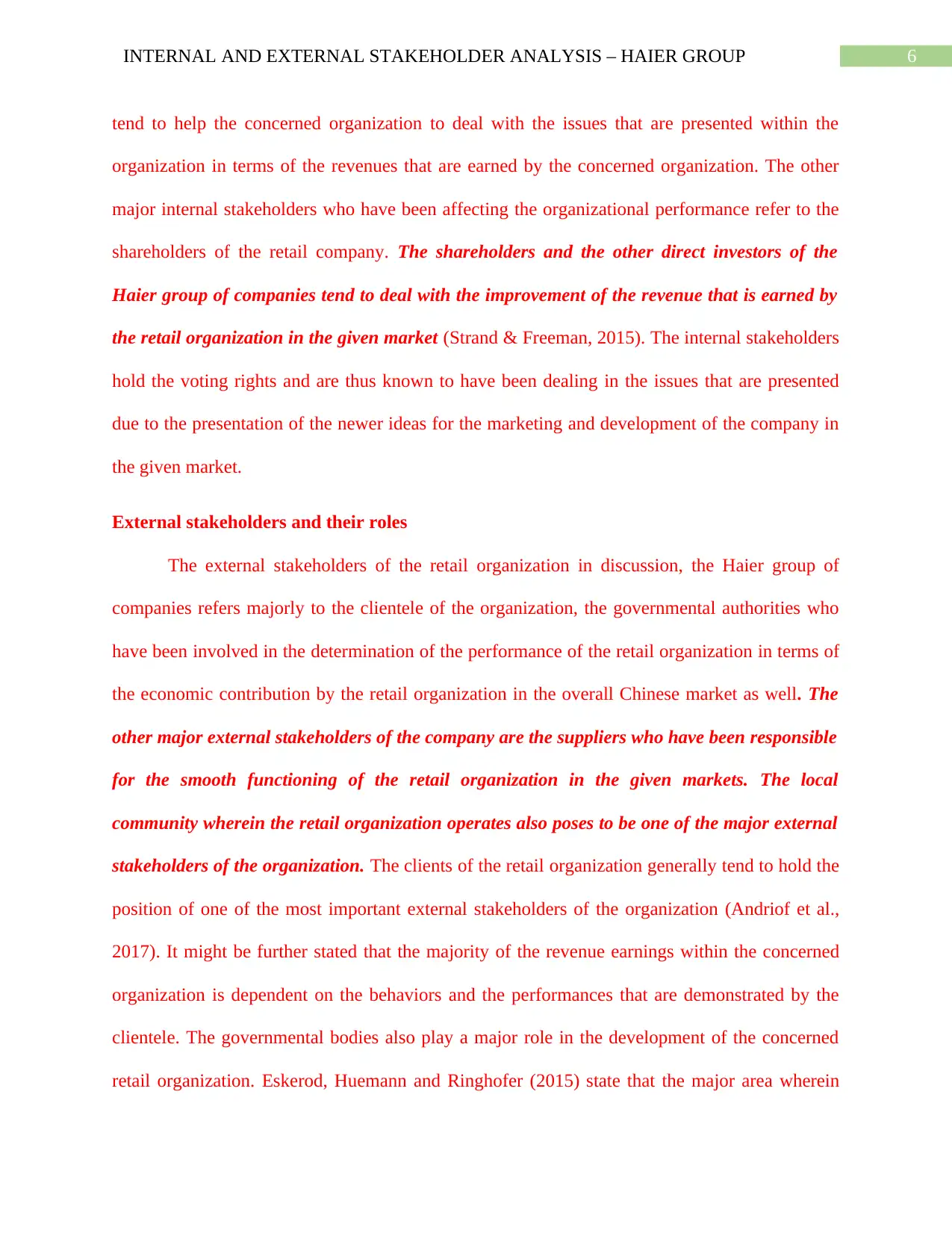
6INTERNAL AND EXTERNAL STAKEHOLDER ANALYSIS – HAIER GROUP
tend to help the concerned organization to deal with the issues that are presented within the
organization in terms of the revenues that are earned by the concerned organization. The other
major internal stakeholders who have been affecting the organizational performance refer to the
shareholders of the retail company. The shareholders and the other direct investors of the
Haier group of companies tend to deal with the improvement of the revenue that is earned by
the retail organization in the given market (Strand & Freeman, 2015). The internal stakeholders
hold the voting rights and are thus known to have been dealing in the issues that are presented
due to the presentation of the newer ideas for the marketing and development of the company in
the given market.
External stakeholders and their roles
The external stakeholders of the retail organization in discussion, the Haier group of
companies refers majorly to the clientele of the organization, the governmental authorities who
have been involved in the determination of the performance of the retail organization in terms of
the economic contribution by the retail organization in the overall Chinese market as well. The
other major external stakeholders of the company are the suppliers who have been responsible
for the smooth functioning of the retail organization in the given markets. The local
community wherein the retail organization operates also poses to be one of the major external
stakeholders of the organization. The clients of the retail organization generally tend to hold the
position of one of the most important external stakeholders of the organization (Andriof et al.,
2017). It might be further stated that the majority of the revenue earnings within the concerned
organization is dependent on the behaviors and the performances that are demonstrated by the
clientele. The governmental bodies also play a major role in the development of the concerned
retail organization. Eskerod, Huemann and Ringhofer (2015) state that the major area wherein
tend to help the concerned organization to deal with the issues that are presented within the
organization in terms of the revenues that are earned by the concerned organization. The other
major internal stakeholders who have been affecting the organizational performance refer to the
shareholders of the retail company. The shareholders and the other direct investors of the
Haier group of companies tend to deal with the improvement of the revenue that is earned by
the retail organization in the given market (Strand & Freeman, 2015). The internal stakeholders
hold the voting rights and are thus known to have been dealing in the issues that are presented
due to the presentation of the newer ideas for the marketing and development of the company in
the given market.
External stakeholders and their roles
The external stakeholders of the retail organization in discussion, the Haier group of
companies refers majorly to the clientele of the organization, the governmental authorities who
have been involved in the determination of the performance of the retail organization in terms of
the economic contribution by the retail organization in the overall Chinese market as well. The
other major external stakeholders of the company are the suppliers who have been responsible
for the smooth functioning of the retail organization in the given markets. The local
community wherein the retail organization operates also poses to be one of the major external
stakeholders of the organization. The clients of the retail organization generally tend to hold the
position of one of the most important external stakeholders of the organization (Andriof et al.,
2017). It might be further stated that the majority of the revenue earnings within the concerned
organization is dependent on the behaviors and the performances that are demonstrated by the
clientele. The governmental bodies also play a major role in the development of the concerned
retail organization. Eskerod, Huemann and Ringhofer (2015) state that the major area wherein
Paraphrase This Document
Need a fresh take? Get an instant paraphrase of this document with our AI Paraphraser
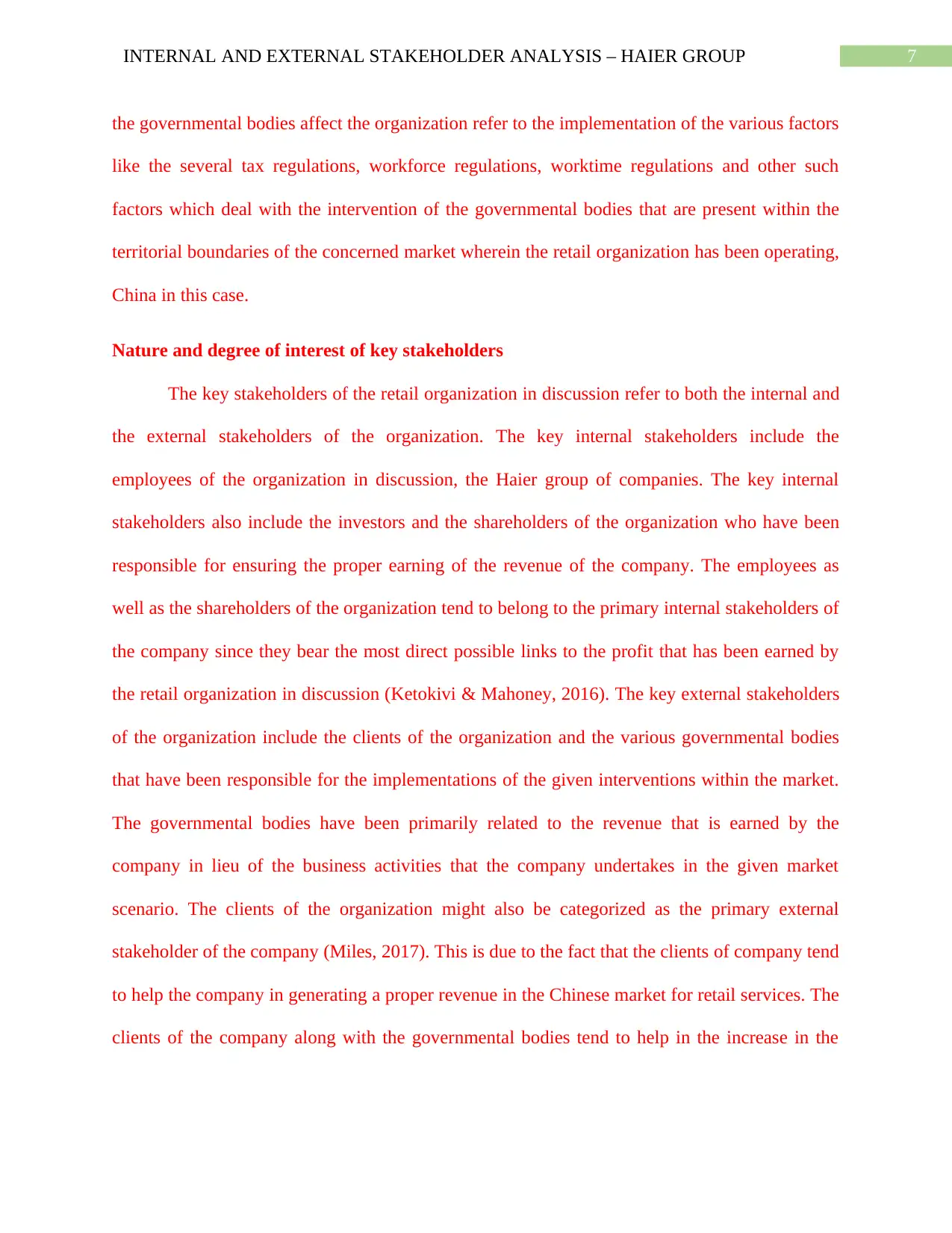
7INTERNAL AND EXTERNAL STAKEHOLDER ANALYSIS – HAIER GROUP
the governmental bodies affect the organization refer to the implementation of the various factors
like the several tax regulations, workforce regulations, worktime regulations and other such
factors which deal with the intervention of the governmental bodies that are present within the
territorial boundaries of the concerned market wherein the retail organization has been operating,
China in this case.
Nature and degree of interest of key stakeholders
The key stakeholders of the retail organization in discussion refer to both the internal and
the external stakeholders of the organization. The key internal stakeholders include the
employees of the organization in discussion, the Haier group of companies. The key internal
stakeholders also include the investors and the shareholders of the organization who have been
responsible for ensuring the proper earning of the revenue of the company. The employees as
well as the shareholders of the organization tend to belong to the primary internal stakeholders of
the company since they bear the most direct possible links to the profit that has been earned by
the retail organization in discussion (Ketokivi & Mahoney, 2016). The key external stakeholders
of the organization include the clients of the organization and the various governmental bodies
that have been responsible for the implementations of the given interventions within the market.
The governmental bodies have been primarily related to the revenue that is earned by the
company in lieu of the business activities that the company undertakes in the given market
scenario. The clients of the organization might also be categorized as the primary external
stakeholder of the company (Miles, 2017). This is due to the fact that the clients of company tend
to help the company in generating a proper revenue in the Chinese market for retail services. The
clients of the company along with the governmental bodies tend to help in the increase in the
the governmental bodies affect the organization refer to the implementation of the various factors
like the several tax regulations, workforce regulations, worktime regulations and other such
factors which deal with the intervention of the governmental bodies that are present within the
territorial boundaries of the concerned market wherein the retail organization has been operating,
China in this case.
Nature and degree of interest of key stakeholders
The key stakeholders of the retail organization in discussion refer to both the internal and
the external stakeholders of the organization. The key internal stakeholders include the
employees of the organization in discussion, the Haier group of companies. The key internal
stakeholders also include the investors and the shareholders of the organization who have been
responsible for ensuring the proper earning of the revenue of the company. The employees as
well as the shareholders of the organization tend to belong to the primary internal stakeholders of
the company since they bear the most direct possible links to the profit that has been earned by
the retail organization in discussion (Ketokivi & Mahoney, 2016). The key external stakeholders
of the organization include the clients of the organization and the various governmental bodies
that have been responsible for the implementations of the given interventions within the market.
The governmental bodies have been primarily related to the revenue that is earned by the
company in lieu of the business activities that the company undertakes in the given market
scenario. The clients of the organization might also be categorized as the primary external
stakeholder of the company (Miles, 2017). This is due to the fact that the clients of company tend
to help the company in generating a proper revenue in the Chinese market for retail services. The
clients of the company along with the governmental bodies tend to help in the increase in the
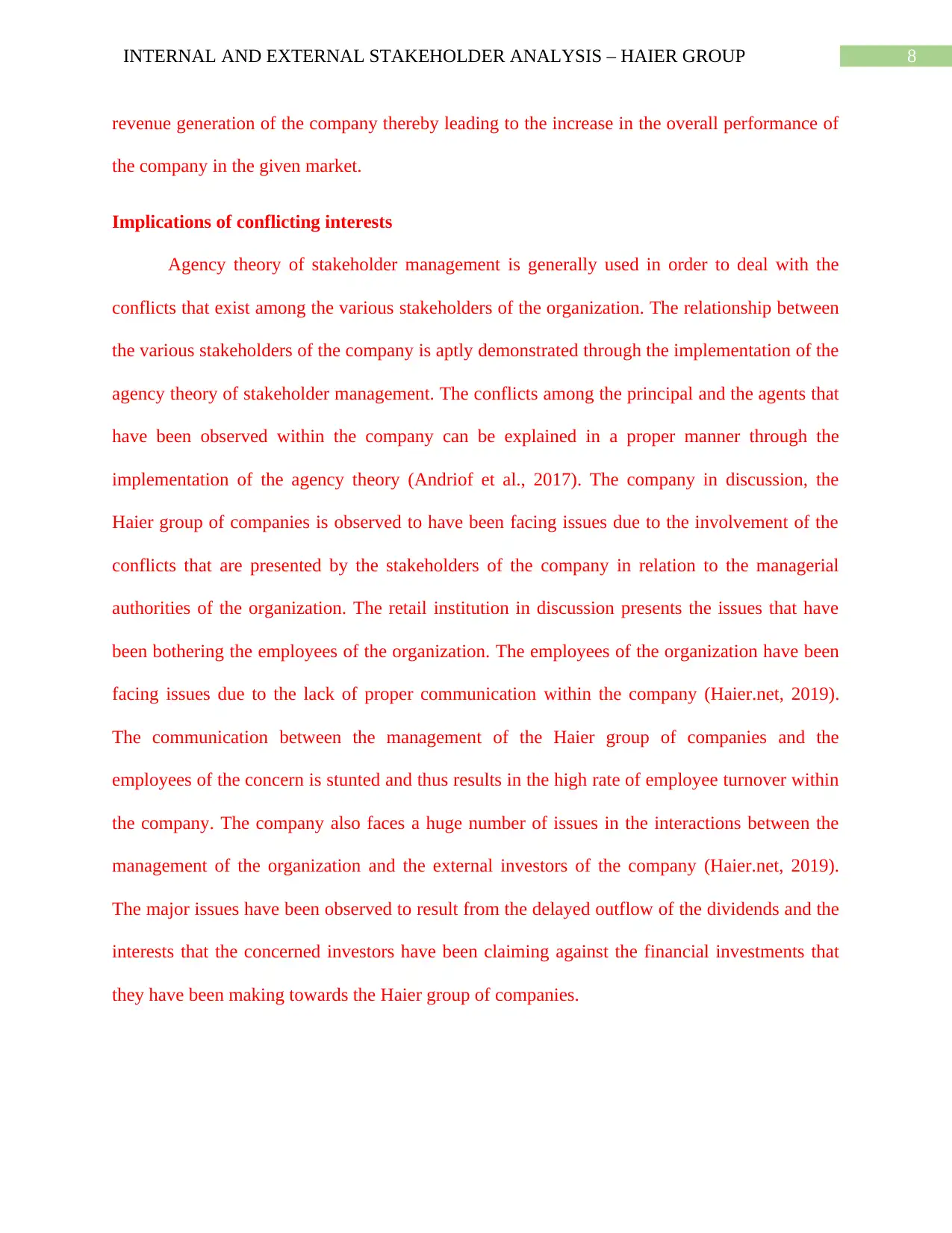
8INTERNAL AND EXTERNAL STAKEHOLDER ANALYSIS – HAIER GROUP
revenue generation of the company thereby leading to the increase in the overall performance of
the company in the given market.
Implications of conflicting interests
Agency theory of stakeholder management is generally used in order to deal with the
conflicts that exist among the various stakeholders of the organization. The relationship between
the various stakeholders of the company is aptly demonstrated through the implementation of the
agency theory of stakeholder management. The conflicts among the principal and the agents that
have been observed within the company can be explained in a proper manner through the
implementation of the agency theory (Andriof et al., 2017). The company in discussion, the
Haier group of companies is observed to have been facing issues due to the involvement of the
conflicts that are presented by the stakeholders of the company in relation to the managerial
authorities of the organization. The retail institution in discussion presents the issues that have
been bothering the employees of the organization. The employees of the organization have been
facing issues due to the lack of proper communication within the company (Haier.net, 2019).
The communication between the management of the Haier group of companies and the
employees of the concern is stunted and thus results in the high rate of employee turnover within
the company. The company also faces a huge number of issues in the interactions between the
management of the organization and the external investors of the company (Haier.net, 2019).
The major issues have been observed to result from the delayed outflow of the dividends and the
interests that the concerned investors have been claiming against the financial investments that
they have been making towards the Haier group of companies.
revenue generation of the company thereby leading to the increase in the overall performance of
the company in the given market.
Implications of conflicting interests
Agency theory of stakeholder management is generally used in order to deal with the
conflicts that exist among the various stakeholders of the organization. The relationship between
the various stakeholders of the company is aptly demonstrated through the implementation of the
agency theory of stakeholder management. The conflicts among the principal and the agents that
have been observed within the company can be explained in a proper manner through the
implementation of the agency theory (Andriof et al., 2017). The company in discussion, the
Haier group of companies is observed to have been facing issues due to the involvement of the
conflicts that are presented by the stakeholders of the company in relation to the managerial
authorities of the organization. The retail institution in discussion presents the issues that have
been bothering the employees of the organization. The employees of the organization have been
facing issues due to the lack of proper communication within the company (Haier.net, 2019).
The communication between the management of the Haier group of companies and the
employees of the concern is stunted and thus results in the high rate of employee turnover within
the company. The company also faces a huge number of issues in the interactions between the
management of the organization and the external investors of the company (Haier.net, 2019).
The major issues have been observed to result from the delayed outflow of the dividends and the
interests that the concerned investors have been claiming against the financial investments that
they have been making towards the Haier group of companies.
⊘ This is a preview!⊘
Do you want full access?
Subscribe today to unlock all pages.

Trusted by 1+ million students worldwide
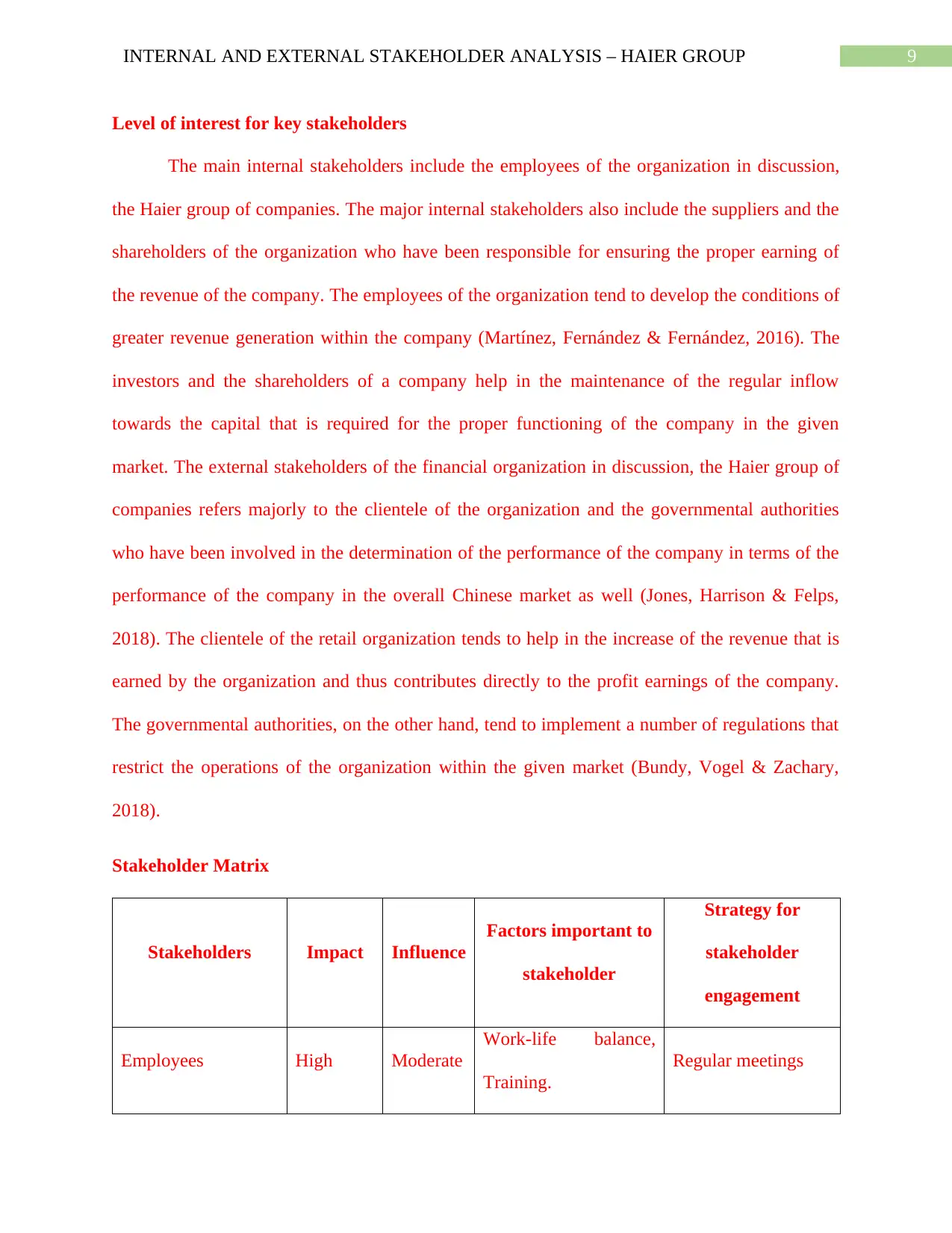
9INTERNAL AND EXTERNAL STAKEHOLDER ANALYSIS – HAIER GROUP
Level of interest for key stakeholders
The main internal stakeholders include the employees of the organization in discussion,
the Haier group of companies. The major internal stakeholders also include the suppliers and the
shareholders of the organization who have been responsible for ensuring the proper earning of
the revenue of the company. The employees of the organization tend to develop the conditions of
greater revenue generation within the company (Martínez, Fernández & Fernández, 2016). The
investors and the shareholders of a company help in the maintenance of the regular inflow
towards the capital that is required for the proper functioning of the company in the given
market. The external stakeholders of the financial organization in discussion, the Haier group of
companies refers majorly to the clientele of the organization and the governmental authorities
who have been involved in the determination of the performance of the company in terms of the
performance of the company in the overall Chinese market as well (Jones, Harrison & Felps,
2018). The clientele of the retail organization tends to help in the increase of the revenue that is
earned by the organization and thus contributes directly to the profit earnings of the company.
The governmental authorities, on the other hand, tend to implement a number of regulations that
restrict the operations of the organization within the given market (Bundy, Vogel & Zachary,
2018).
Stakeholder Matrix
Stakeholders Impact Influence
Factors important to
stakeholder
Strategy for
stakeholder
engagement
Employees High Moderate
Work-life balance,
Training.
Regular meetings
Level of interest for key stakeholders
The main internal stakeholders include the employees of the organization in discussion,
the Haier group of companies. The major internal stakeholders also include the suppliers and the
shareholders of the organization who have been responsible for ensuring the proper earning of
the revenue of the company. The employees of the organization tend to develop the conditions of
greater revenue generation within the company (Martínez, Fernández & Fernández, 2016). The
investors and the shareholders of a company help in the maintenance of the regular inflow
towards the capital that is required for the proper functioning of the company in the given
market. The external stakeholders of the financial organization in discussion, the Haier group of
companies refers majorly to the clientele of the organization and the governmental authorities
who have been involved in the determination of the performance of the company in terms of the
performance of the company in the overall Chinese market as well (Jones, Harrison & Felps,
2018). The clientele of the retail organization tends to help in the increase of the revenue that is
earned by the organization and thus contributes directly to the profit earnings of the company.
The governmental authorities, on the other hand, tend to implement a number of regulations that
restrict the operations of the organization within the given market (Bundy, Vogel & Zachary,
2018).
Stakeholder Matrix
Stakeholders Impact Influence
Factors important to
stakeholder
Strategy for
stakeholder
engagement
Employees High Moderate
Work-life balance,
Training.
Regular meetings
Paraphrase This Document
Need a fresh take? Get an instant paraphrase of this document with our AI Paraphraser
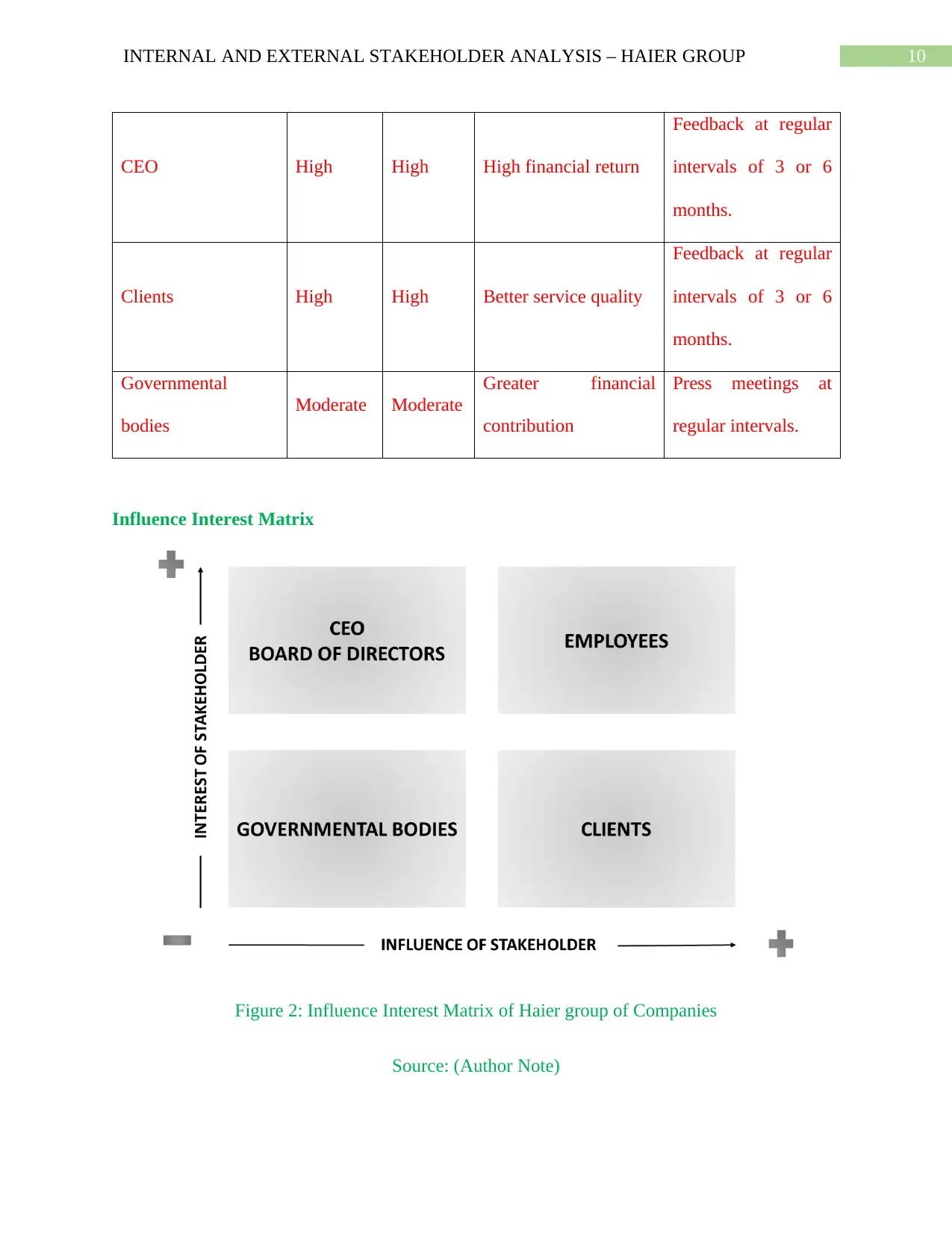
10INTERNAL AND EXTERNAL STAKEHOLDER ANALYSIS – HAIER GROUP
CEO High High High financial return
Feedback at regular
intervals of 3 or 6
months.
Clients High High Better service quality
Feedback at regular
intervals of 3 or 6
months.
Governmental
bodies
Moderate Moderate
Greater financial
contribution
Press meetings at
regular intervals.
Influence Interest Matrix
Figure 2: Influence Interest Matrix of Haier group of Companies
Source: (Author Note)
CEO High High High financial return
Feedback at regular
intervals of 3 or 6
months.
Clients High High Better service quality
Feedback at regular
intervals of 3 or 6
months.
Governmental
bodies
Moderate Moderate
Greater financial
contribution
Press meetings at
regular intervals.
Influence Interest Matrix
Figure 2: Influence Interest Matrix of Haier group of Companies
Source: (Author Note)
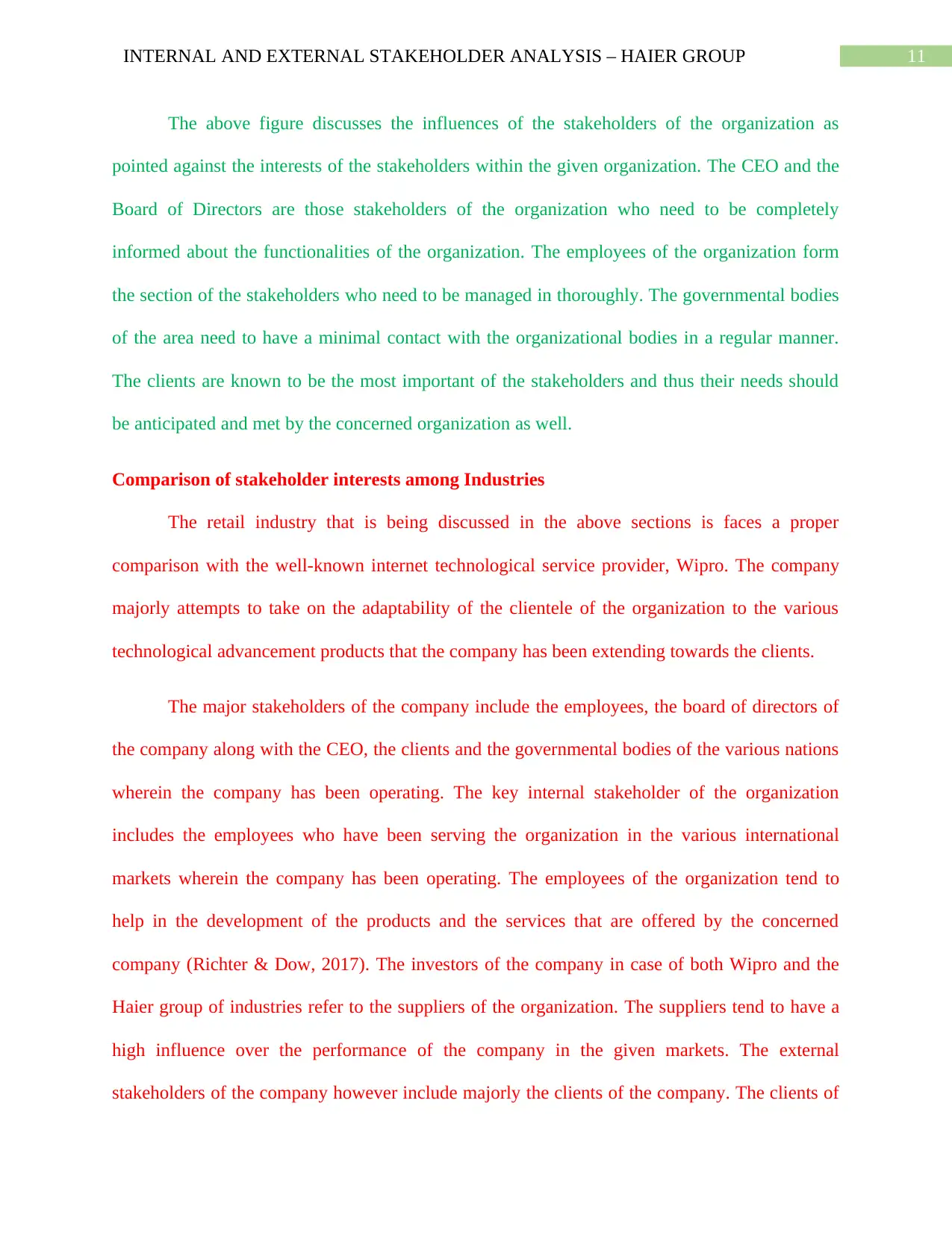
11INTERNAL AND EXTERNAL STAKEHOLDER ANALYSIS – HAIER GROUP
The above figure discusses the influences of the stakeholders of the organization as
pointed against the interests of the stakeholders within the given organization. The CEO and the
Board of Directors are those stakeholders of the organization who need to be completely
informed about the functionalities of the organization. The employees of the organization form
the section of the stakeholders who need to be managed in thoroughly. The governmental bodies
of the area need to have a minimal contact with the organizational bodies in a regular manner.
The clients are known to be the most important of the stakeholders and thus their needs should
be anticipated and met by the concerned organization as well.
Comparison of stakeholder interests among Industries
The retail industry that is being discussed in the above sections is faces a proper
comparison with the well-known internet technological service provider, Wipro. The company
majorly attempts to take on the adaptability of the clientele of the organization to the various
technological advancement products that the company has been extending towards the clients.
The major stakeholders of the company include the employees, the board of directors of
the company along with the CEO, the clients and the governmental bodies of the various nations
wherein the company has been operating. The key internal stakeholder of the organization
includes the employees who have been serving the organization in the various international
markets wherein the company has been operating. The employees of the organization tend to
help in the development of the products and the services that are offered by the concerned
company (Richter & Dow, 2017). The investors of the company in case of both Wipro and the
Haier group of industries refer to the suppliers of the organization. The suppliers tend to have a
high influence over the performance of the company in the given markets. The external
stakeholders of the company however include majorly the clients of the company. The clients of
The above figure discusses the influences of the stakeholders of the organization as
pointed against the interests of the stakeholders within the given organization. The CEO and the
Board of Directors are those stakeholders of the organization who need to be completely
informed about the functionalities of the organization. The employees of the organization form
the section of the stakeholders who need to be managed in thoroughly. The governmental bodies
of the area need to have a minimal contact with the organizational bodies in a regular manner.
The clients are known to be the most important of the stakeholders and thus their needs should
be anticipated and met by the concerned organization as well.
Comparison of stakeholder interests among Industries
The retail industry that is being discussed in the above sections is faces a proper
comparison with the well-known internet technological service provider, Wipro. The company
majorly attempts to take on the adaptability of the clientele of the organization to the various
technological advancement products that the company has been extending towards the clients.
The major stakeholders of the company include the employees, the board of directors of
the company along with the CEO, the clients and the governmental bodies of the various nations
wherein the company has been operating. The key internal stakeholder of the organization
includes the employees who have been serving the organization in the various international
markets wherein the company has been operating. The employees of the organization tend to
help in the development of the products and the services that are offered by the concerned
company (Richter & Dow, 2017). The investors of the company in case of both Wipro and the
Haier group of industries refer to the suppliers of the organization. The suppliers tend to have a
high influence over the performance of the company in the given markets. The external
stakeholders of the company however include majorly the clients of the company. The clients of
⊘ This is a preview!⊘
Do you want full access?
Subscribe today to unlock all pages.

Trusted by 1+ million students worldwide
1 out of 17
Related Documents
Your All-in-One AI-Powered Toolkit for Academic Success.
+13062052269
info@desklib.com
Available 24*7 on WhatsApp / Email
![[object Object]](/_next/static/media/star-bottom.7253800d.svg)
Unlock your academic potential
Copyright © 2020–2025 A2Z Services. All Rights Reserved. Developed and managed by ZUCOL.





